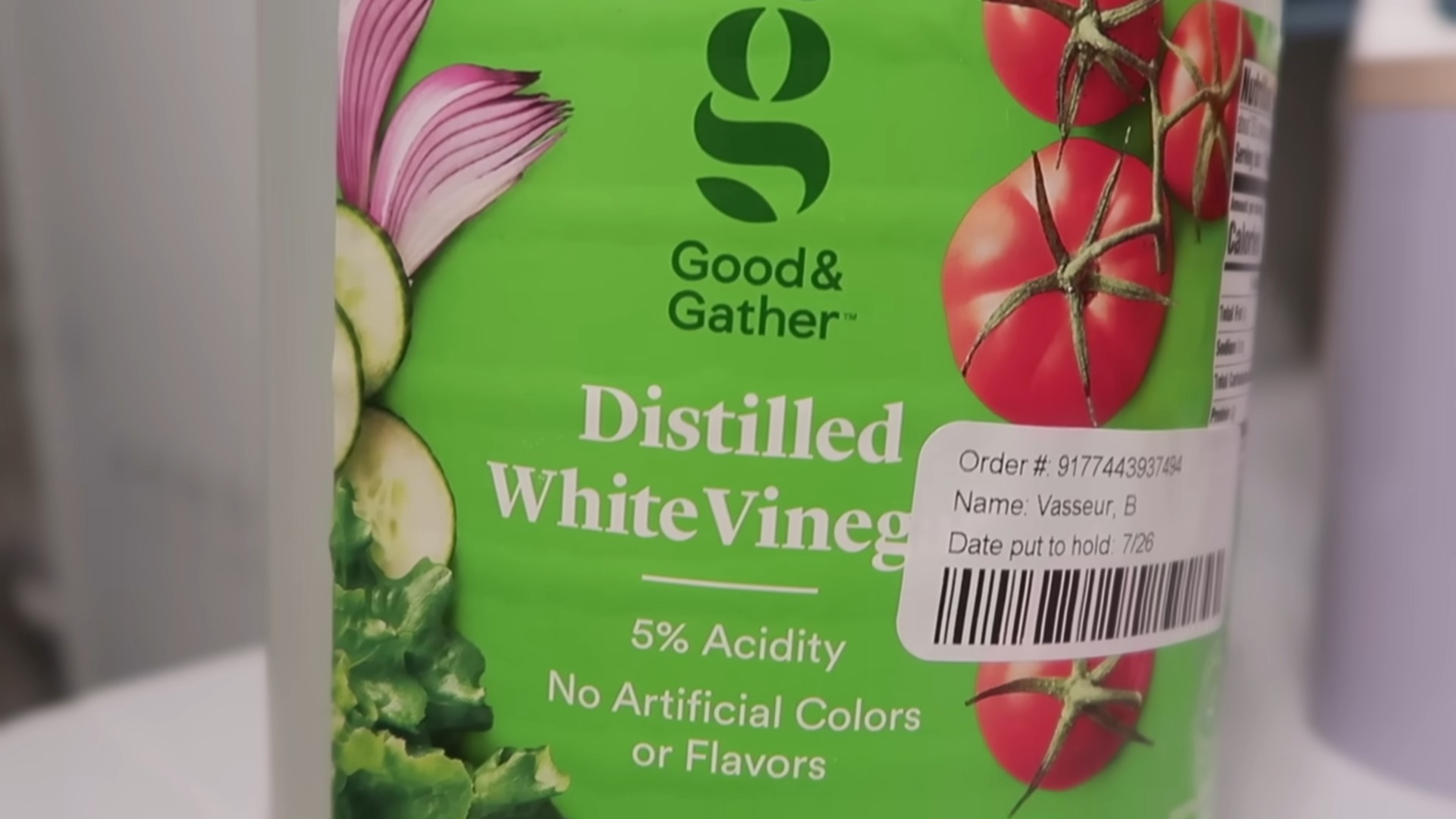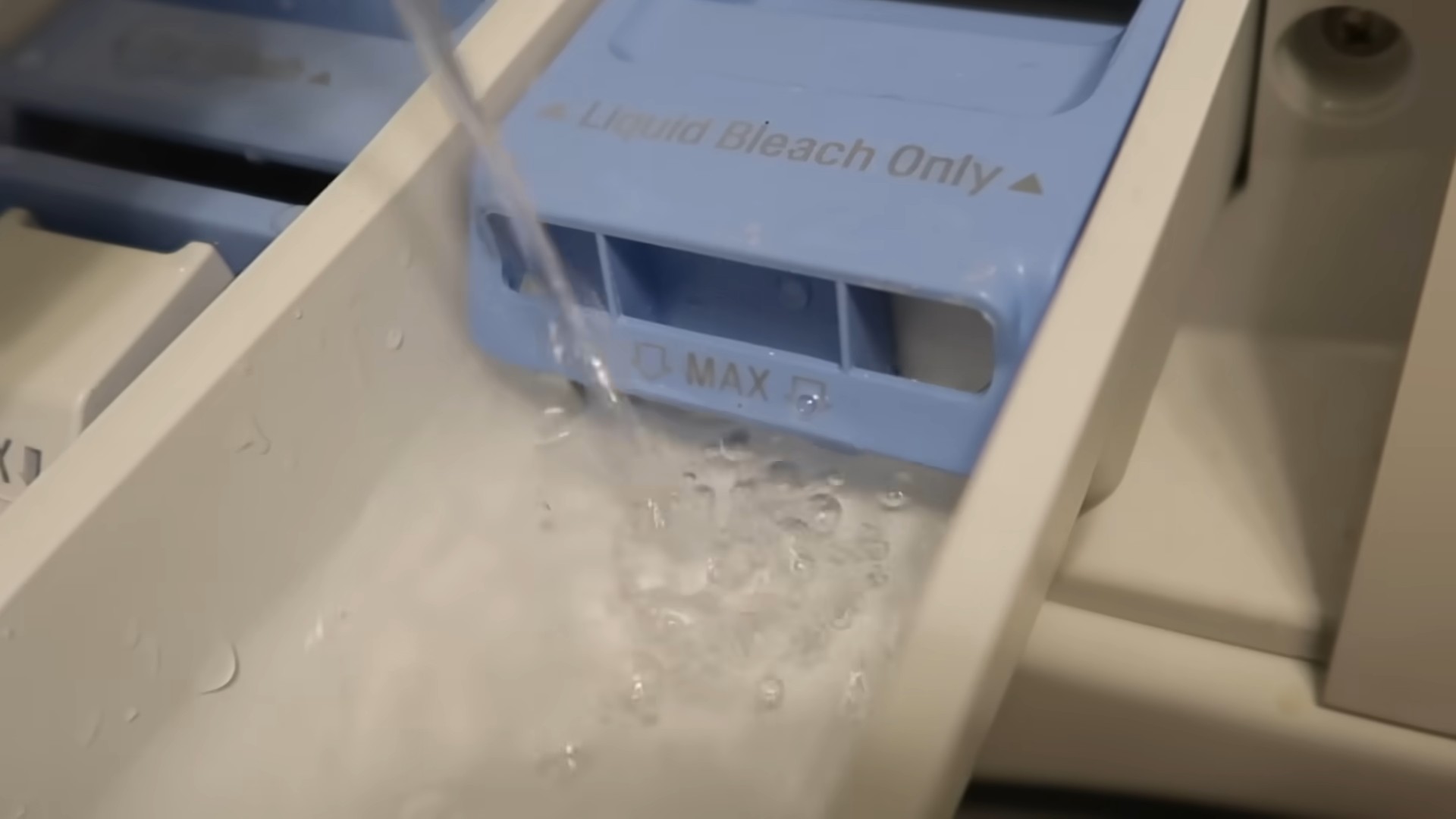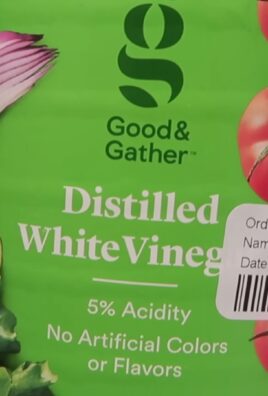Vinegar cleaning hacks – who knew this humble kitchen staple could be your secret weapon to a sparkling home? I’m constantly amazed by the versatility of vinegar, and I’m excited to share some of my favorite DIY cleaning tricks that will save you money and reduce your reliance on harsh chemicals.
For centuries, vinegar has been more than just a condiment. Ancient civilizations, from the Babylonians to the Romans, used it for everything from preserving food to disinfecting wounds. Its natural acidity makes it a powerful cleaning agent, and its affordability makes it a budget-friendly alternative to commercial cleaners.
In today’s world, we’re all looking for ways to simplify our lives and make more sustainable choices. That’s where these vinegar cleaning hacks come in! Whether you’re battling stubborn stains, tackling grimy surfaces, or just looking for a natural way to freshen up your home, I’ve got you covered. These DIY tricks are easy to follow, use readily available ingredients, and deliver impressive results. Say goodbye to expensive, chemical-laden cleaners and hello to a cleaner, greener, and more affordable home!

Unlocking the Cleaning Power of Vinegar: My Favorite DIY Hacks
Vinegar, that humble bottle sitting in your pantry, is a cleaning superhero in disguise! I’ve been using it for years, and I’m constantly amazed by its versatility and effectiveness. Plus, it’s eco-friendly and budget-friendly – a win-win! Let me share some of my go-to vinegar cleaning hacks that will leave your home sparkling.
General Vinegar Cleaning Tips
Before we dive into specific projects, here are some general tips to keep in mind when cleaning with vinegar:
* Dilution is Key: Always dilute vinegar with water, especially when cleaning delicate surfaces. A 50/50 solution is usually a good starting point.
* Test First: Before applying vinegar to any surface, test it in an inconspicuous area to ensure it doesn’t cause discoloration or damage.
* Ventilation is Important: Vinegar has a strong odor, so make sure to open windows or turn on a fan while cleaning.
* Don’t Mix with Bleach: This is crucial! Mixing vinegar with bleach creates toxic chlorine gas. Never, ever do it.
* White Vinegar is Best: While other types of vinegar might work in a pinch, distilled white vinegar is the most effective and versatile for cleaning.
Cleaning Your Microwave with Vinegar
Microwaves can get incredibly grimy, and scrubbing them can be a real pain. This vinegar trick makes it so much easier!
What You’ll Need:
* 1 cup water
* 1/2 cup white vinegar
* Microwave-safe bowl
* Clean cloth or sponge
Step-by-Step Instructions:
1. Combine Water and Vinegar: In the microwave-safe bowl, mix the water and vinegar.
2. Microwave the Mixture: Place the bowl in the microwave and heat it on high for 5-10 minutes. The mixture should boil and create steam.
3. Let it Sit: Leave the microwave door closed for another 5 minutes to allow the steam to loosen the grime.
4. Wipe Clean: Carefully remove the bowl (it will be hot!). Use the clean cloth or sponge to wipe down the inside of the microwave. The loosened grime should come off easily.
5. Stubborn Spots: For any stubborn spots, dip the cloth or sponge in the vinegar solution and scrub gently.
Deodorizing and Cleaning Your Dishwasher with Vinegar
Dishwashers can harbor odors and buildup over time. Vinegar to the rescue! This is a simple way to keep your dishwasher fresh and clean.
What You’ll Need:
* 1 cup white vinegar
* Dishwasher-safe bowl or cup
Step-by-Step Instructions:
1. Prepare the Vinegar: Fill the dishwasher-safe bowl or cup with 1 cup of white vinegar.
2. Place in Dishwasher: Place the bowl or cup on the top rack of the empty dishwasher.
3. Run a Hot Cycle: Run the dishwasher on a hot cycle.
4. Repeat Monthly: I like to do this once a month to keep my dishwasher smelling fresh and working efficiently.
Cleaning Your Coffee Maker with Vinegar
Coffee makers can accumulate mineral deposits that affect the taste of your coffee. Vinegar is a fantastic descaler!
What You’ll Need:
* White vinegar
* Water
* Coffee maker
* Coffee filter
Step-by-Step Instructions:
1. Prepare the Vinegar Solution: Fill the coffee maker’s water reservoir with a 50/50 mixture of white vinegar and water.
2. Run a Brewing Cycle: Place a clean coffee filter in the basket and run a full brewing cycle.
3. Rinse with Water: After the vinegar cycle, discard the vinegar solution and fill the reservoir with fresh water. Run two or three brewing cycles with just water to rinse away any remaining vinegar.
4. Enjoy Fresh Coffee: Your coffee maker should now be clean and ready to brew delicious coffee!
Removing Hard Water Stains with Vinegar
Hard water stains can be a real eyesore on faucets, showerheads, and shower doors. Vinegar is a natural and effective way to remove them.
What You’ll Need:
* White vinegar
* Spray bottle (optional)
* Cloth or sponge
* Plastic bag (for showerheads)
* Rubber band (for showerheads)
Step-by-Step Instructions:
1. Prepare the Vinegar: You can use undiluted white vinegar for this task. If you’re using a spray bottle, fill it with vinegar.
2. Apply to Surfaces:
* Faucets: Spray the vinegar directly onto the faucet or apply it with a cloth or sponge.
* Shower Doors: Spray the vinegar onto the shower door or apply it with a cloth or sponge.
* Showerheads: Fill a plastic bag with vinegar and secure it around the showerhead with a rubber band, ensuring the showerhead is submerged in the vinegar.
3. Let it Soak: Allow the vinegar to soak for at least 30 minutes, or even longer for stubborn stains. For showerheads, I usually leave it overnight.
4. Scrub and Rinse: After soaking, scrub the surfaces with a cloth or sponge to remove the loosened mineral deposits. Rinse thoroughly with water.
5. Repeat if Necessary: If the stains are particularly stubborn, you may need to repeat the process.
Cleaning Windows and Mirrors with Vinegar
Vinegar is a fantastic natural cleaner for windows and mirrors, leaving them streak-free and sparkling.
What You’ll Need:
* 1/4 cup white vinegar
* 2 cups water
* Spray bottle
* Microfiber cloth or newspaper
Step-by-Step Instructions:
1. Prepare the Cleaning Solution: In the spray bottle, mix the vinegar and water.
2. Spray the Surface: Spray the vinegar solution onto the window or mirror.
3. Wipe Clean: Use a clean microfiber cloth or crumpled newspaper to wipe the surface dry. Newspaper works surprisingly well and leaves a streak-free shine!
4. Enjoy Sparkling Windows: Admire your sparkling clean windows and mirrors!
Freshening Laundry with Vinegar
Vinegar can be used in your laundry routine to freshen clothes, remove odors, and soften fabrics.
What You’ll Need:
* White vinegar
Step-by-Step Instructions:
1. Odor Removal: Add 1 cup of white vinegar to the washing machine during the rinse cycle to help remove odors from clothes.
2. Fabric Softener: Add 1/2 cup of white vinegar to the fabric softener dispenser to naturally soften fabrics.
3. Brighten Whites: Add 1/2 cup of white vinegar to the wash cycle to help brighten white clothes.
4. Important Note: Never mix vinegar with bleach in the washing machine.
Cleaning Your Cutting Boards with Vinegar
Cutting boards can harbor bacteria and odors. Vinegar is a great way to disinfect and deodorize them.
What You’ll Need:
* White vinegar
* Clean cloth or sponge
Step-by-Step Instructions:
1. Wipe with Vinegar: After each use, wipe down your cutting board with white vinegar.
2. Let it Sit: Allow the vinegar to sit on the surface for a few minutes to disinfect.
3. Rinse with Water: Rinse the cutting board thoroughly with water.
4. For Odors: For lingering odors, you can sprinkle baking soda on the cutting board after wiping with vinegar, let it sit for a few minutes, and then rinse.
Unclogging Drains with Vinegar and Baking Soda
This is a classic DIY drain cleaner that’s much safer and more eco-friendly than harsh chemical drain cleaners.
What You’ll Need:
* 1 cup baking soda
* 1 cup white vinegar
* Hot water
Step-by-Step Instructions:
1. Pour in Baking Soda: Pour the baking soda down the drain.
2. Add Vinegar: Pour the vinegar down the drain after the baking soda.
3. Let it Fizz: Let the mixture fizz and bubble for about 30 minutes.
4. Flush with Hot Water: After 30 minutes, flush the drain with hot water.
5. Repeat if Necessary: If the drain is still clogged, repeat the process.
Cleaning Grout with Vinegar and Baking Soda
Grout can get stained and discolored over time. This vinegar and baking soda paste is a powerful grout cleaner.
What You’ll Need:
* Baking soda
* White vinegar
* Old toothbrush or grout brush
* Spray bottle
Step-by-Step

Conclusion
So, there you have it! Unlocking the power of vinegar for a sparkling clean home is not just a trend; it’s a revolution in eco-friendly and budget-conscious cleaning. We’ve explored several incredible vinegar cleaning hacks that will transform the way you approach household chores. From banishing stubborn hard water stains to deodorizing your refrigerator and reviving your laundry, vinegar proves to be a versatile and surprisingly effective solution.
But why is this DIY approach a must-try? Firstly, it’s incredibly cost-effective. A single bottle of vinegar can replace a multitude of expensive, specialized cleaning products, saving you money in the long run. Secondly, it’s environmentally friendly. By opting for vinegar, you’re reducing your reliance on harsh chemicals that can pollute waterways and harm your health. You’re contributing to a cleaner, greener planet, one sparkling surface at a time. Thirdly, it’s surprisingly effective. Many people are skeptical at first, but once they witness the cleaning power of vinegar firsthand, they’re converted.
Don’t be afraid to experiment with variations! For a more pleasant scent, infuse your vinegar with citrus peels (lemon, orange, or grapefruit work beautifully) for a few weeks before using it. Add a few drops of your favorite essential oil, like lavender or tea tree, for an extra boost of fragrance and antibacterial properties. For tougher stains, create a paste of vinegar and baking soda for a powerful scrubbing action. Remember to always test any cleaning solution in an inconspicuous area first, especially on delicate surfaces.
We’ve covered a lot of ground, but the best way to truly appreciate the magic of vinegar is to try these hacks yourself. Start with a simple task, like cleaning your microwave or descaling your showerhead. Witness the results, and you’ll be amazed at how easily and effectively vinegar tackles grime and dirt.
We’re confident that these vinegar cleaning hacks will become staples in your cleaning routine. They’re simple, affordable, and effective, making them a win-win for both your home and the environment.
Now, we want to hear from you! Have you tried any of these vinegar cleaning hacks? Do you have any secret vinegar cleaning tips of your own? Share your experiences and insights in the comments below. Let’s create a community of vinegar-powered cleaning enthusiasts and inspire others to embrace this natural and effective cleaning solution. Your feedback is invaluable, and we can all learn from each other’s experiences. So, grab a bottle of vinegar, get cleaning, and let us know how it goes! We can’t wait to hear your success stories!
Frequently Asked Questions (FAQs)
Is vinegar safe to use on all surfaces?
No, vinegar is not safe to use on all surfaces. While it’s a fantastic cleaner for many things, its acidity can damage certain materials. Avoid using vinegar on natural stone surfaces like marble, granite, and travertine, as it can etch and dull the finish. It’s also best to avoid using vinegar on waxed wood furniture, as it can strip the wax and damage the wood. Additionally, avoid using vinegar on electronics screens, as it can damage the anti-glare coating. Always test vinegar in an inconspicuous area before applying it to a larger surface. When in doubt, consult the manufacturer’s instructions for the specific surface you’re cleaning.
What type of vinegar is best for cleaning?
The best type of vinegar for cleaning is plain white distilled vinegar. It’s inexpensive, readily available, and has a consistent acidity level (usually around 5%) that makes it effective for cleaning without being overly harsh. Avoid using flavored vinegars, such as apple cider vinegar or balsamic vinegar, as they may contain sugars or other additives that can leave a sticky residue. While apple cider vinegar can be used in some cleaning applications, white distilled vinegar is generally the preferred choice for its clarity and consistent cleaning power.
Can I mix vinegar with bleach?
Never mix vinegar with bleach! This combination creates chlorine gas, which is highly toxic and can cause serious respiratory problems, burns, and even death. Always use vinegar and bleach separately, and never in the same cleaning solution. If you’ve used bleach to clean a surface, rinse it thoroughly with water before applying vinegar. Safety should always be your top priority when cleaning.
How do I get rid of the vinegar smell after cleaning?
The vinegar smell typically dissipates within a few hours. To speed up the process, you can open windows and doors to ventilate the area. You can also place bowls of baking soda around the room to absorb the odor. Another option is to simmer a pot of water with citrus peels or spices like cinnamon and cloves to create a pleasant aroma that will mask the vinegar smell. Adding a few drops of your favorite essential oil to your cleaning solution can also help to minimize the vinegar scent.
Can vinegar kill mold?
Yes, vinegar can kill mold, but it’s most effective on surface mold. Vinegar’s acidity helps to break down the mold spores and prevent them from growing. To kill mold with vinegar, spray undiluted white distilled vinegar onto the affected area and let it sit for at least an hour. Then, scrub the area with a brush and wipe it clean with a damp cloth. For more stubborn mold growth, you may need to repeat the process or use a stronger cleaning solution. However, it’s important to note that vinegar may not be effective on all types of mold, and it’s not a substitute for professional mold remediation in cases of severe mold infestation.
How can I use vinegar to clean my washing machine?
To clean your washing machine with vinegar, pour 2 cups of white distilled vinegar into the detergent dispenser. Run the washing machine on a hot water cycle. For a top-loading machine, allow the machine to fill with water and then let it soak for an hour before completing the cycle. This will help to remove detergent buildup, mineral deposits, and odors from the washing machine. You can also clean the rubber seals around the door with a vinegar solution to prevent mold and mildew growth. Repeat this process every few months to keep your washing machine clean and fresh.
Can I use vinegar to clean my dishwasher?
Yes, you can use vinegar to clean your dishwasher. To clean your dishwasher with vinegar, place a dishwasher-safe cup filled with white distilled vinegar on the top rack of the empty dishwasher. Run the dishwasher on a hot water cycle. The vinegar will help to remove food particles, grease, and mineral deposits from the dishwasher. This will leave your dishwasher clean, fresh, and functioning efficiently. Repeat this process every month to maintain a clean dishwasher.
What are some other creative uses for vinegar in cleaning?
Vinegar is incredibly versatile! You can use it to clean your microwave by heating a cup of vinegar and water for a few minutes, then wiping down the interior. It’s great for descaling showerheads – soak them in a vinegar solution overnight. You can even use it to remove stickers and adhesive residue. Diluted vinegar can also be used as a natural weed killer in your garden. The possibilities are endless!





Leave a Comment